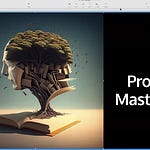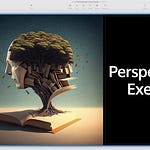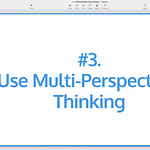Video clip source: Daily Journal Meeting
Quick Summary
Ambitious people fail because they focus only on achieving goals while ignoring what to avoid—making the same mistakes as Harvard Business School graduates who ended up wealthy but with broken marriages and estranged children. Charlie Munger's "inversion" mental model flips achievement on its head: instead of asking "What do I want?" first ask "What do I want to avoid?" This counterintuitive approach helped build one of the world's top 10 largest companies and is backed by over 100 scientific studies.
Early Reviews Of The Prompt
“This may be one of the best posts I have ever read. Bravo! Thank you for sharing your research. Love the combination of diverse backgrounds you have pulled from. It’s exactly how I couple things in learning. My brain feels very happy right now. And… I have some work to do.”
—Celeste
“Michael, this was terrific. Not only the prompt, but how you contextualized and connected it to the history of the inversion model and your personal practice with it. ChatGPT listed four strengths/weaknesses for me. Each one felt validating and useful. Together, they felt like a 360 overview. Hearing it articulated makes it more of an object in my awareness and the effect overall is energizing.”
—Christopher
What You Get In Today’s Post
Free Subscribers
Overview of what the inversion mental model is and why it’s so powerful
Link to academic research that backs it up
Excerpt from a 1986 Harvard Commencement speech where Munger explains how to apply the Inversion mental model
Harvard case study featuring a legendary professor, which explains how inversion helps ambitious people avoid a hidden trap
Personal story of how the Inversion mental model changed my life
Paid Subscribers
Get a memory-powered ChatGPT prompt that immediately helps you apply the mental model:
Identifies your strengths based on your past conversations
Reveals how each strength could backfire over time (if you’re not proactive)
Shares how the dark sides of these strengths can combine to keep you stuck in life without you understanding why
The Power of Inversion: Seeing What Others Miss
“Invert, always invert: Turn a situation or problem upside down. Look at it backward. What happens if all our plans go wrong? Where don’t we want to go, and how do you get there? Instead of looking for success, make a list of how to fail instead–through sloth, envy, resentment, self-pity, entitlement, all the mental habits of self-defeat. Avoid these qualities and you will succeed. Tell me where I’m going to die so I don’t go there.”
—Charlie Munger
Why Inversion Works
The power of inversion lies in its counterintuitive approach:
While most achievement-oriented people focus exclusively on their goals, Munger reversed the process.
Instead of only asking "What do I want?" he insisted on asking "What do I want to avoid?"
This seemingly simple shift helped him build one of the world's top 10 largest companies alongside Warren Buffett.
By thinking backward, we can identify the invisible traps waiting in our path—traps that many people discover only after it's too late.
The Science Behind It
Over 100 scientific studies on mental contrasting confirm that inversion is effective: people who visualize obstacles and develop action plans to overcome them take more effective action than those who only fantasize about success.
How To Apply Inversion
In 1986, Munger gave a speech at Harvard, which was essentially about what not to do in life. It’s a gem, and it shows how he uses inversion. The speech was inspired by a talk Johnny Carson gave that Munger heard.
EXCERPT FROM CHARLIE MUNGER 1986 HARVARD SPEECH
"What Carson said was that he couldn’t tell the graduating class how to be happy, but he could tell them from personal experience how to guarantee misery. Carson’s prescriptions for sure misery included:
1. Ingesting chemicals in an effort to alter mood or perception;
2. Envy; and
3. Resentment.
I can still recall Carson’s absolute conviction as he told how he had tried these things on occasion after occasion and had become miserable every time.
It is easy to understand Carson’s first prescription for misery - ingesting chemicals. I add my voice. The four closest friends of my youth were highly intelligent, ethical, humorous types, favoured in person and background. Two are long dead, with alcohol a contributing factor, and a third is a living alcoholic - if you call that living. While susceptibility varies, addiction can happen to any of us, through a subtle process where the bonds of degradation are too light to be felt until they are too strong to be broken. And I have yet to meet anyone, in over six decades of life, whose life was worsened by overfear and overavoidance of such a deceptive pathway to destruction.
Envy, of course, joins chemicals in winning some sort of quantity price for causing misery. It was wreaking havoc long before it got a bad press in the laws of Moses. If you wish to retain the contribution of envy to misery, I recommend that you never read any of the biographies of that good Christian, Samuel Johnson, because his life demonstrates in an enticing way the possibility and advantage of transcending envy.
Resentment has always worked for me exactly as it worked for Carson. I cannot recommend it highly enough to you if you desire misery. Johnson spoke well when he said that life is hard enough to swallow without squeezing in the bitter rind of resentment. For those of you who want misery, I also recommend refraining from practice of the Disraeli compromise, designed for people who find it impossible to quit resentment cold turkey. Disraeli, as he rose to become one of the greatest Prime Ministers, learned to give up vengeance as a motivation for action, but he did retain some outlet for resentment by putting the names of people who wronged him on pieces of paper in a drawer. Then, from time to time, he reviewed these names and took pleasure in noting the way the world had taken his enemies down without his assistance.”Now that we understand the concept of inversion, let's examine how this mental model reveals hidden traps that even the most successful people can fall into. The following case study illustrates how inverting our perspective on achievement can provide life-changing insights into long-term fulfillment.
Case Study: Inversion Helps Us Understand The Hidden Failure Pattern Among High Achievers
Source: TED
In this profound lecture titled "How Will You Measure Your Life?", the late Harvard professor Clayton Christensen takes a rare and personal look back on his life.
In the two years prior, he had been diagnosed with cancer and suffered a stroke. So, rather than discussing disruptive innovation—the business theory that made him famous—he chose instead to address what truly matters in life.
With the clarity that often comes from confronting one's own mortality, Christensen revealed a disturbing pattern he observed among his Harvard Business School classmates:
Upon graduation, everyone had positive ambitions about their future.
At their fifth reunion, everyone appeared happy and successful.
Yet as they reached later milestones, a disturbing story emerged.
The fairytales turned into nightmares:
Many of his classmates became estranged from their children, who were being raised by another parent on another coast.
Their marriages had collapsed.
Some faced legal troubles.
Others battled health issues.
These weren't the lives they had planned.
Christensen illuminates why with the following quote:
"Everyone here is driven to achieve. And when you have an extra ounce of energy or an extra 30 minutes of time, instinctively and unconsciously you'll allocate it to whatever activities in your life give you the most immediate evidence of achievement."
This clip is profound because it illustrates how even our greatest strengths can become our tragic flaws if we remain blind to their downsides. Said differently, over time, their greatest strengths became their greatest weaknesses.
This pattern exists more widely among high achievers.
Therefore, one of the most powerful applications of the inversion model is exploring how your strengths can blindside us in the future.
While theory and case studies demonstrate the power of inversion, my own experience provides a tangible example of how this mental model can transform one's life trajectory…
Personal Story: Three Ways Inversion Changed My Life
After learning about inversion and Christensen’s story, I did three things which changed my life…
Study the lessons of wise elders along with research on successful aging
Study late adult development stages I didn’t even know existed
Make difficult and deep transformations in my life
#1. Study the lessons of wise elders along with research on successful aging
One summer, just before my 40th birthday, I spent over 100+ hours studying aging. I was feeling particularly mortal.
I figured, “Why reinvent the wheel when billions of people have come before me and over 1,000 studies have been published on the topic?”
This deep dive led me to research and write These 7 brutal truths about aging will help you get your shit together, which directly confronts harsh truths about aging that are often overlooked by people in their 30s and 40s. Furthermore, I wrote Your Work Peak Is Later Than You Think, According To Research, after reading an article entitled Your Work Peak Is Earlier Than You Think.
Both articles were inspired by my application of the inversion model and the resulting understanding of what could go wrong as I aged.
#2. Study late adult development stages
This deep dive into adult development—a field based on over 100,000 surveys and interviews conducted over 50 years—revealed how we transform internally in profound ways as we age. After 300 hours of research, I discovered five key concepts related to adult development, which I ended up writing about:
#3. Making difficult and deep transformations in my life
On a personal note, doing the deep dives above helped me see that I was on a more dangerous path than I had realized:
I didn’t have checkups with doctors or dentists. For example, I didn’t go to the dentist for seven years. Despite not having any symptoms, the cavity on one tooth grew so much that it had to be extracted. I’m going to get a dental implant in a few months, but the gap in the tooth reminds me of the gap in my logic.
I had trouble personally relaxing and spending quality time with my family without feeling guilty about not being productive. At our lowest point, this nearly threatened my relationship with my wife. Over time, I’ve changed my paradigm where quality time with loved ones feels like the most “productive” thing I could do.
I lacked emotional intelligence, which led to overwhelm with parenting, resulting in my wife bearing a greater burden of parenting, which in turn caused resentment. I now understand that being strong cognitively led me to undervalue emotional intelligence.
I was toxically comparing myself to others, which caused persistent stress, which caused overwork. At its worst, I would pull all-nighters when I felt my identity was threatened. Over time, I learned to view these manias as opportunities to relax and address the root cause rather than trying to outwork my anxiety.
I was sacrificing my inner experience for outer metrics that weren’t even important to me in the end. In retrospect, I can say that I didn’t really understand what it meant to have a rich inner life. Without knowing how rich my moment-to-moment experience could be, it was easy to sacrifice it for external things that held an illusory promise.
Over the last decade, my life has undergone profoundly positive changes by facing these challenges using inversion and transforming them into the richest parts of my life.
The Scrooge Effect
Like Ebenezer Scrooge in A Christmas Carol, we don't have to wait years until our tragic flaws manifest and bear consequences. By glimpsing our potential future, we can change it now.
To apply inversion to your own life, consider:
What are your greatest strengths?
How might each strength backfire in ways you'd easily overlook?
How might these blindspots combine to create a meta-trap?
What systems can you implement today to prevent these outcomes?
What might your life look like if you don’t make the changes?
To help you take these exact steps, I've created a memory-powered prompt that walks you through them. In addition, I provide you with five follow-up questions to extract more value from the prompt.
Let’s jump in…
Preview: Small Sample Of What You’ll Get When You Use The Prompt
Copy & Paste This AI Prompt
(For Paid Subscribers)
After copying and pasting the prompt below into ChatGPT, use the follow-up questions I share in step #2 to get the most out of ChatGPT's response...











